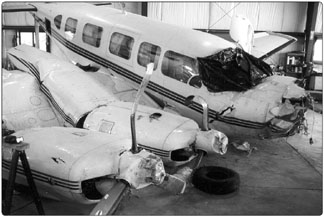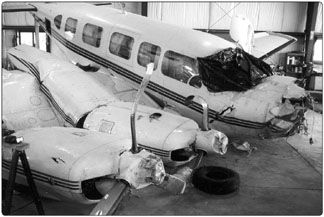
By Frank Farwell
As pilots, we often deny that a mid-air, engine failure, in-flight fire or other deadly mishap could happen to us. Today, anyway. So we let our guard down. We deny the inevitable, and take the easy way out. We get lazy, complacent; firmly in denial, we put our faith in Garmin, Bendix-King and S-Tec and let them fly the plane.
I used to be that kind of guy. Maybe it was because I kept immaculate care of my Skylane, Bonanza, Malibu and King Air E90, and went to recurrent training every six or 12 months. I was a God-fearing, tax-paying, respectable, plain-vanilla, mid-time pilot who lived by the rules and followed his checklists twice. How could I get burned? I wondered.
Three near-fatal encounters in four years changed my thinking.
When I tell my tales (see sidebar) to pilot acquaintances, I keep score of who listens, and who doesnt. About a third take careful notes and seemingly plan to address some of the things they can control, like buying a high-flow oxygen bottle with a fixed-to-tank mask that very day. The other two-thirds blow off the tale as something that will never happen to them. They are the segment most apt to suffer serious injury-or worse-when something goes sour while they are PIC. They have unknowingly disabled the mental software that could have led them to survival. They are practitioners of human denial, and are putting their lives unnecessarily at risk.
In which of these camps do you find yourself? Are you the pessimistic type, never leaving anything to chance and equipping yourself and your airplane to deal with emergencies? Or, are you the eternal optimist-as far as flying goes-who believes everything will be okay?
Healthy Pessimism
To live to be an old pilot with stacks of logbooks to your credit and sweet memories of grass strips and smooth tarmac in faraway places, we need either continuous good luck-which is quite unlikely-or a healthy sense of applied pessimism. To survive in the long run, we must assume failures will occur on every flight. The fact your aircraft may have had perfect maintenance is of no consequence whatsoever-how many accidents reports note that nothing wrong with the [insert offending compenent here] could be found?
Being current in our proficiency is a big step in the right direction. But what about the other pilots, controllers, mechanics or factory workers bonehead mistakes? Are we ready for them to try to kill us with a bad vector, a mid-air collision, or improperly installed or manufactured part?
Trainings Role
If you presume that everything will eventually fail, and will do so at the worst possible time, you can train for these scenarios and beat brainlock before it happens. This is what simulator training, and its accompanying intensive ground school, is all about. Students-and were all students, right?-attending well-structured initial and recurrent training sessions learn aircraft systems, and practice failures until the proper reaction becomes automatic.
High-quality simulator training is a gift from the march of technological innovation and modern accident investigation. Use it to the max by signing up for the nastiest program you can find, and schedule an extra day for emergencies. Better yet, do them at night when you are hungry, have had insufficient sleep and just want to get home.
My brain (and knees) at first went to jelly that night when my Malibus new big-bore Continental engine went silent. Every pilot who has survived a similar event with whom Ive spoken since said he or she thought pretty much the same things at the time: This cant be happening…Its too unreal…Must be a bad dream…I have a spouse and kids…I paid all my debts..Theres an important meeting tomorrow…The day after is my daughters birthday…There must be some mistake…
While denial-its not just a river in Egypt-runs through our minds, precious seconds tick away. We forfeit altitude and airspeed, and put ourselves further away from the nearest suitable airport. Brainlock takes us firmly in its jaws.
The good news is that overcoming brainlock is something we can learn to overcome before it happens, thanks to the welcome world of hellish sims.Using them religiously can make our minds the most useful emergency gear in the cockpit.
Understanding this may be the toughest lesson of flying.
Combating Brainlock
In one very real sense, it all comes down to training. After all, you still have to fly the airplane, and its your training that prepares you for the challenge of an in-flight emergency. The first change in the engines tone, a new vibration or even sudden silence should give rise to the same instincts you learned when your primary CFI pulled the throttle and the carb heat, announcing, Youve just lost your engine.
Its easy to forget about all the bad things that can happen while aloft and, instead, marvel at the utility and efficiency of your airplane and the beauty of the landscape unfolding below it. But that airplane is just another machine, comprised of nuts and bolts, sheet and stamped metal, composites, gaskets and O-rings and wiring. Machines fail. Parts wear out. Thats why we train, why we practice, why we study and why we have checklists and procedures-so that when something bad happens, we can react appropriately, quickly and make the best of what may be a really unfortunate day.
When was the last time you went out for some real dual instruction in emergency procedures? Did you run through all of the different checklists-not just the engine-out procedures? What about the emergency landing gear extension checklist? Do you know where the landing gear circuit breaker is?Do you know how to disable the autopilot in the event of a runaway trim situation? If you fly a twin, when was the last time you secured the critical engine-if you have one-feathered the prop for real and flew around like that for a while? When was the last time you landed at night without using the landing lights?
Are any of these procedures familiar to you? Do you think you can perform them on a dark and stormy night, with the kids crying in the back seat and ATC asking for fuel and souls aboard?
Emergency Equipment
A soup-to-nuts emergency equipment checklist could run for pages and cost valuable weight and space in the airplane, not to mention a bunch of money.The real question is, What do we need for this particular flight? If we are flying over remote parts of the far north we need an axe, rifle, fishing rod, hooks, matches, warm clothes, sleeping bag, plastic tarp, warm clothes, mirror, flares, a week of food, cell phone, GPS, mosquito netting, et al. If we are flying a one-hour run from Milwaukee to Detroit we can forget the mosquito netting, but wed better have a life raft, life preserver, strobe light, flares, warm clothes and a cell phone in a waterproof bag, maybe even with a solar charger. Lake Michigan is free of sharks, but it can be a cold, lonely place most of the year if something goes awry.
If its an ocean crossing flight to the Caribbean, the components list is altered slightly: Delete the shotgun and tent, hold on to the raft, food, water, GPS, EPIRB, strobe light and cell phone, and add sun protection clothing and dark glasses.
The common items for all flights are of course food (energy bars are a good start) and water, a cell phone in a waterproof bag, a strobe beacon (check West Marines catalog), and either an EPIRB (West Marine) or, better yet, a transmitting GPS (Sportys).
Build an exhaustive list on your word processor, and challenge yourself to add to it over time. Print it out and carry it in your kneeboard so you can brainstorm new items during a long cross-country flight. When it comes time for your next flight, print out the new version and check the items that are pertinent to the terrain, distance, water, heat, cold, etc. you will be flying over. Assemble the items for the flight type you are doing and put them in high-visibility, waterproof bags (one for food, one for equipment), with lines attached. Keep it by the emergency exit point of the aircraft so you can grab it on your way out. Dont fall in the trap of having the contents scattered around the plane. When problems begin, youll have your hands full.
Are You Ready Now?
But you already knew that. The question is: Did you do anything about it? Is your bag of tricks packed, ready to help you survive your next challenge?
Also With This Article
“The Pessimists Equipment List”
“The Anti-Brainlock Checklist”
“A Tale Of Three Close Calls”
-Frank Farwell is a 1900-hour Commercial pilot living in Madison, Wis.




